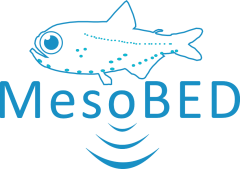MesoBED is funded by GSRT and HFRI in the framework of the “1st Call for the support of Postdoctoral Researchers”. The duration is 30 months (October 2018 – March 2021) and the budget is 155,000 €. The project is hosted by the Hellenic Centre for Marine Research (Greece) while IMR (Norway) is a contributing partner.
MesoBED is structured in three scientific Work Packages (WP) and one WP dedicated to project management and dissemination of the activities and results.

WP1 – Distribution of mesopelagic fish
WP1 aims at the analysis of distribution and biomass estimation of the mesopelagic fish in selected study areas. Field surveys will take place on board a research vessel in at least two selected study areas in the Aegean and Ionian Seas in order to collect information on the distribution, behaviour (e.g., Diel Vertical Migration) and abundance of the mesopelagic fish community. Multi-frequency scientific echosounders will be used to measure the backscattering echo from the DSL and the deriving echograms will be scrutinized using appropriate software. In parallel with the acoustic surveys, ground truthing will be held to analyse the species composition of the DSL using pelagic trawls and other sampling equipment towed at different depths. In addition, the vertical profiles of environmental parameters will be measured at a grid of stations in the study areas and zooplankton samples from different depth strata will be collected. Fish and zooplankn samples will be transferred to the laboratory for further analyses. Following the data collection, the relationship of mesopelagic fish distribution with environmental variables will be explored. In addition, echo integration will allow to estimate the biomass of mesopelagic fish in the study areas assuming Target Strength (TS) values reported in the literature taking also into account the related uncertainty.
WP2 – Biology of mesopelagic fish
WP2 includes laboratory analyses of fish samples collected in the field surveys. The goal is to study the biology of mesopelagic fish populations, including aspects of reproductive strategies (e.g., sex ratio, maturity, fecundity), length-weight relationships, age and growth. This is considered basic information for most fish species; however this knowledge is generally lacking for the understudied mesopelagic fish, especially for eastern Mediterranean populations.
WP3 – Ecological role of mesopelagic fish
In the framework of WP3, diet preferences and feeding strategies of mesopelagic fish species will be studied. Stomach contents will be analyzed and the effect of factors such as time of day and DVM will be explored. The knowledge gained, along with (i) a review of the feeding habits of potential predators, (ii) the biomass estimates from WP1 and (iii) biological parameters estimated in WP2 will be used to parameterise an ecosystem model in order to explore the ecological role of mesopelagic fish. The “Ecopath with Ecosim” approach will be used to represent the trophic links and the ecosystem structure in one of the selected study areas and to quantify the energy transfers within the food web which are related to the mesopelagic fish community as well as their impact on other groups.
WP4 – Project management and dissemination
WP4 includes horizontal actions which ensure the coordinated workflow among different tasks, the successful delivery of technical reports and deliverables and decision making to anticipate potential risks and problems. In addition, WP4 will disseminate the project results to the target audiences (scientists, stakeholders and the wider public) through scientific publications, presentations in conferences and meetings and production of dissemination material.

